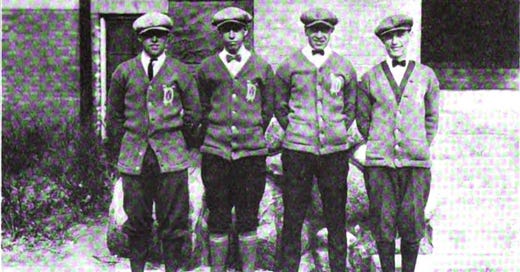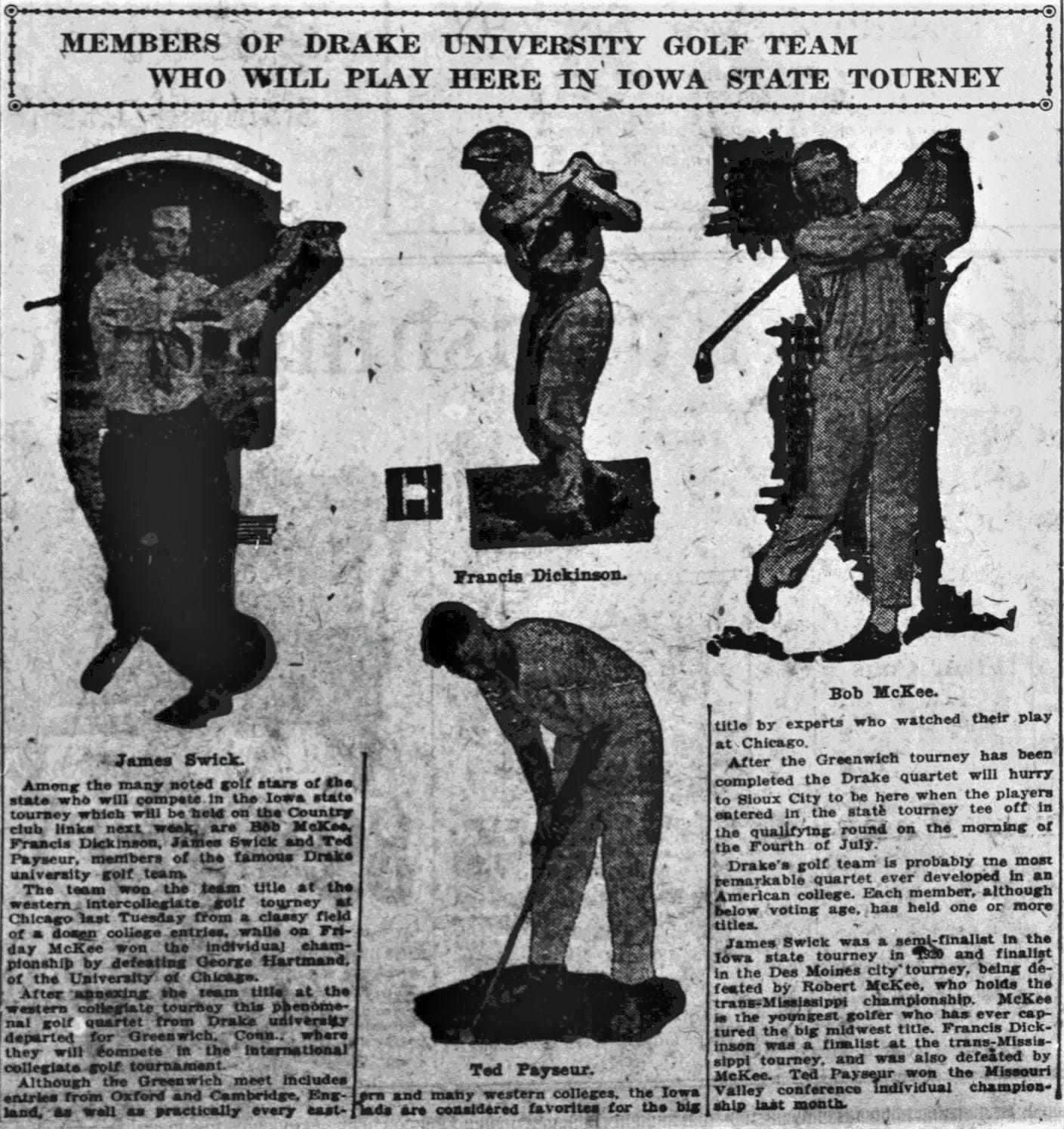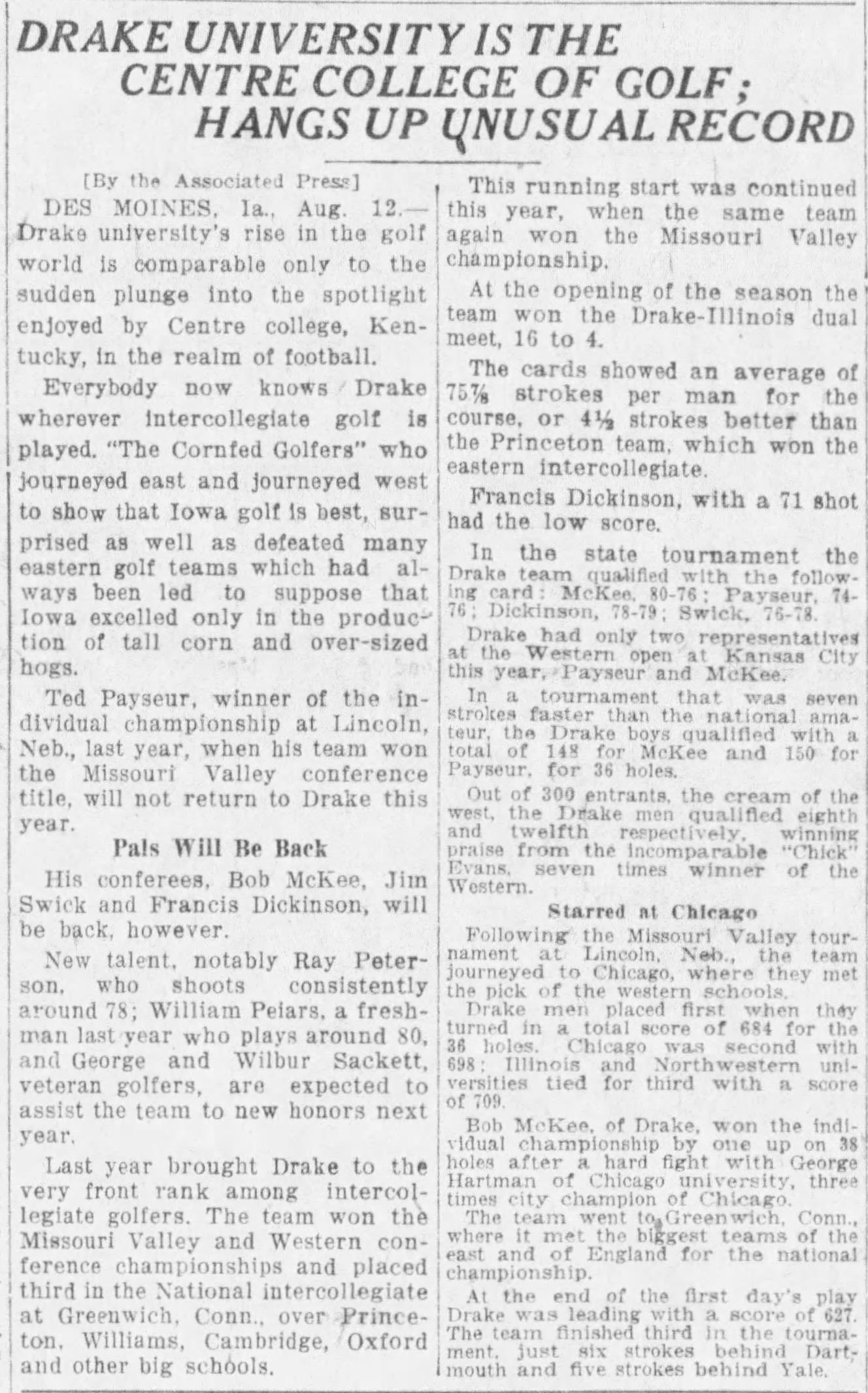TED PAYSEUR: BULLDOG, WILDCAT, AND ONE OF THE COLLEGE GOLF G.O.A.T.s
It’s hard to be more connected to college golf history than Theodore “Ted” Payseur. From player to coach to athletic director and prominent NCAA committee chairman, Payseur touched all aspects of collegiate golf on the men’s side, and even has direct connections to the rise of women’s intercollegiate golf following WWII. Over the span of 40+ years from the 1920s-60s, this “cornfed golfer” from Iowa was a central figure as college golf expanded from a primarily East Coast competition to a truly national sport.
THIS IS PART 1 OF 2
PLAYER
Drake University Golf and Basketball Star [1918-1922]
Like many golfers of his time, Ted Payseur was a multi-sport athlete who represented the Drake Bulldogs very well. In 2006, Payseur was was named to Drake’s all-time men’s basketball team. He was described as “the first Drake basketball star ever” and credited with bringing Drake “out of the Missouri Valley Conference cellar” as a multi-year All-MVC team player. As good as he was on the hardwood court, he seems to have been even better on the grass course. What he and the Drake golf team accomplished during the 1920,1921, and 1922 seasons had an incredible impact that ranged far beyond the small Iowa campus.

Missouri Valley Champions
While not the best team in the Missouri Valley in most sports, Drake University golf was immediately the best from the very first conference championship played in 1921. The tournament was instituted by Nebraska’s Athletic Director, Fred Lushring, who by all accounts put on a fair test of a championship. At the end of 72 holes played over two long, grueling days, Drake came out on top over Nebraska and Washington by an incredible 150+ strokes. Ted Payseur was the first ever MVC individual champion with his 9 stroke victory over teammate, captain Robert McKee.
The same Drake crew - well, almost the same - returned the next year and continued their incredible success, with time with a 120+ stroke victory over Nebraska and Kansas. This time, however, it was captain McKee who took the individual trophy by 26 strokes over teammate Dickinson. We say almost the same because James Swick was ruled ineligible at the last minute due to an academic issue. Although Payseur was graduated and gone for the 1923 campaign, Drake returned to complete the three-peat with McKee winning his second individual title and Swick as the runner-up.
Impact on the Big Ten
Before WWI, many of the teams that became part of the conference known as the Big Ten1 - an informal moniker for what was formally known as the Intercollegiate Conference all the way until the 1980s - did not have golf teams, and so there was no official golf championship until after the war.
The first Big Ten golf championship, as recognized in the conference record book, was staged at Olympia Fields in October 1920, and included 6 of the 10 conference members (Chicago, Ohio State, Illinois, Michigan, Northwestern, and Wisconsin) as well as one non-member, Drake University. While it seems strange that Drake would have been included, keep in mind two things: 1) in these early days of “conference” play, they would sometimes include other schools in the region, as was soon seen in the Southern Intercollegiate Conference, and 2) before the war, there had already been a loose informal golf championship of sorts for teams in this region known as the “Western Intercollegiate”. In fact, many newspapers at the time of the 1920 playing referred to this Big Ten championship as the “Western Intercollegiate.”
No matter what you call it, the tournament was played over 36 holes with two players representing each team. Drake’s two-player team consisting of captain Robert “Bob” McKee and Francis Dickinson took home the team title at 28 over par (“28 down” to par), while the University of Chicago’s Rudy Knepper took home individual medalist honors at “7 down.”
The next year, Northwestern Athletic Director Dana Evans was put in charge of staging the event, which he schedule at the end of June at nearby Indian Hills. The format was changed to match the “national” championship put on by the IGA which consisted of a 4-man team 36-hole stroke play event to determine the team champion, and which also served as the qualifier for an individual match play bracket to determine the individual title winner. After nearly cancelling the event due to a lack of teams - several deciding at the last minute that school examinations and vacation plans were more important - it championship proceeded with Drake, Illinois, Chicago, Northwestern, and Lewis Institute all sending 4-man teams, while Wisconsin only sent three players (two qualified for match play). The same Drake team that dominated the Missouri Valley championship a month prior won handily with a 14 stroke victory over Chicago. Payseur (173 in stroke play) and Dickinson (170) lost their early individual matches, but captain McKee (161) made it to the Finals where he defeated the stroke play medalist, George Harman [Chicago] (157), on the 38th hole to become Big Ten/“Western Intercollegiate” champion.
It’s impossible to say for sure that Drake, a non-member, winning the conference championship the first two years was the reason that the Big Ten decided to limit the field to only conference members starting in 1922, but it’s not hard to imagine that is the case. Regardless, the exclusivity of the event was met with some derision as the following newspaper article hotly emphasizes.
1921 IGA National Championship
Although young and without an adult over the voting age acting as coach of the team, the Drake team used the money raised before heading to the Big Ten championship to take a train from Chicago to Greenwich, Connecticut to compete in the national championship run by the Intercollegiate Golf Association (IGA). This was not only the first time in school history that golfers had competed in this championship, they also represented the first team from the state of Iowa and indeed the westernmost university (previously Illinois) to ever compete for the “national” title.
Princeton was the obvious team favorite coming in as the three-time defending champion (1916, 1919, 1920) with maybe Yale next as they had won the title on this very course in 1915, but Drake came in with a fair bit of swagger as the following anecdote in Payseur’s Des Moines Register Hall of Fame write-up attests:
The Ivy League had always dominated the meet and teams from Oxford and Cambridge in England were present. McKee, who had won the medal in the Big Ten meet, was not awed by the event, surroundings or competition. Shortly after arrival, and before hitting a competitive shot, McKee went to the Western Union office and wrote out a telegram: "At the end of first round we are ... strokes ahead of the field." Then, according to Payseur, he told the operator, "Get ready to send this to the governor of the state of Iowa and I'll call and fill in the figure." The figure was 12. The Bulldogs led by a dozen strokes after the first day.
The first day of play consisted of 36 holes of stroke play which saw the Drake team jump out to an early lead behind captain McKee, who lead the field with a 149, and Payseur close behind with a 151. All that stood between Drake and the national title was one more 36-hole day.
The unique format used at that time meant that these final 36 holes would be the only ones that counted towards the individual qualifying portion, after which the medalist and 31 others would go into a match play bracket to play for the individual title. McKee and Payseur finished T3 and T6 respectively in this 36-hole individual qualifying, however the fact that every single Drake player shot at least 4 strokes higher than the previous days meant that they slipped out of the top spot in the 72-hole team portion. Although deeply disappointed, “The Cornfed Golfers” from (seemingly) Nowhere, Iowa managed to finish 3rd on the biggest stage, only six strokes behind Dartmouth (their first team title), five behind Yale, and one stroke ahead of Princeton and the invading group from Cambridge. In the individual match play portion, both McKee (1st round) and Dickinson (2nd round) would lose to Jess Sweetser, Yale superstar and eventual runner-up. Payseur was also put out in the second round in a close match with Princeton’s Wintringer that went to the 18th hole.
In athletics, you learn something when you get beat. I don’t remember everyone I beat, but I remember everyone who beat me.
-Ted Payseur, quoted in his Des Moines Register HoF profile
Drake had another incredibly successful season in 1922, but couldn’t travel to the IGA championship because Swick was still ineligible due to his academics. Drake wouldn’t make another team appearance in the championship until 1926. In the end, Payseur didn’t get a chance to compete again as a player since he graduated in 1922, but his impact on the national championship was far from over.
Thanks for reading! We will conclude our historic profile on Ted Payseur in Part II by looking at his time at Northwestern as a coach, athletic director, and NCAA Golf Committee Representative.
The “Big Ten” Conference actually predates the NCAA, having formally come into existence in the 1890s. As mentioned above, they were formally known as the Intercollegiate Conference, which was stamped/etched into their conference awards, until the 1980s, but their more informal monikers were how they were usually referenced. At first they were the “Western Conference” as opposed to the “Eastern” schools (essentially Ivy Leagues), and as early as 1899 known even as the “Big Nine” based on the number of member schools. A few changes involving Michigan, Ohio State, and others eventually made that number an even 10, and they were referred to as the “Big Ten” around 1916-17. After the University of Chicago dropped football and then full membership around WWII, the conference was again the “Big Nine” for a while, but with the inclusion of Michigan State in 1949 they were finally back to the “Big Ten”, a name they kept even after expanding beyond 10 members in later years.






